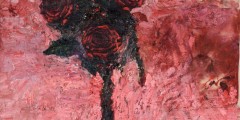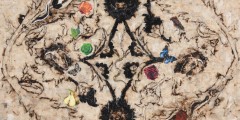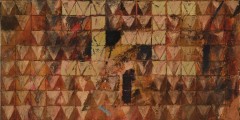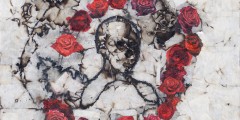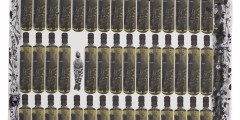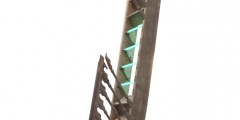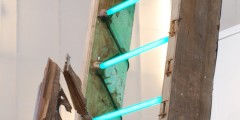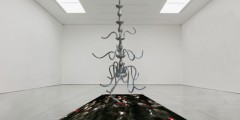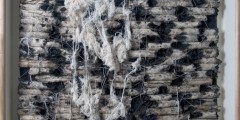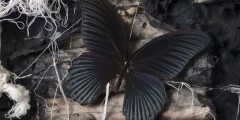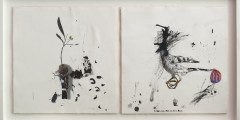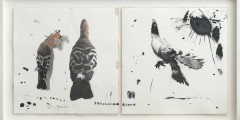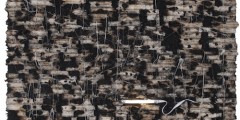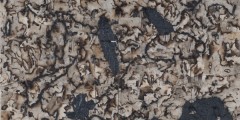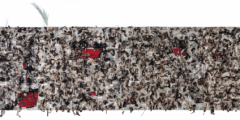Biography
Regarded as one of Iraq’s leading and most innovative contemporary artists, Hanaa Malallah has reached international acclaim through her profoundly visceral, mixed-media compositions which are the embodiment of three decades of war and violence in Iraq. Her latest works generate poignant reflections upon the destruction and devastation of the 2003 U.S.-led invasion and subsequent occupation of Iraq.
Born in 1958 in the Thi Qar Province of Iraq, where the ancient city of Ur was located, Malallah moved to Baghdad with her family when she was just five years old. As a child, she assisted her mother with embroidery work, a creative skill that would carry through to her own adult artistic production in the stitching of her canvases. At the age of 14, Malallah was one of twelve students selected for admission to the Baghdad Institute of Fine Arts, where she studied painting and graphic design under the guidance of Iraq’s “Pioneer” generation of artists, including Faik Hassan and Shakir Hassan al Said, who were instrumental in bringing western modernism to the country. Al Said, a co-founder of the Baghdad Modern Art group, became a life-long friend and mentor of Malallah and his destructive style of painting, which included burning and piercing canvases, greatly influenced Malallah’s own art.
The turmoil of the 1980’s in Iraq was fundamental to the development of Mallah’s practice, who along with ten other prominent artists, collectively known as the Eighties Generation, chose to stay in the country during the Iran-Iraq war (1980-1988) and the Gulf War (1990-1991). Severe travel restrictions, economic hardship and social instability, not to mention the horror that accompanies war, radically affected the creative output of these artists. Isolated from the rest of the art world, the Eighties Generation artists reflected upon the current state of Iraqi society while incorporating the cultural history of Mesopotamia in their practices, often drawing inspiration from the relics in the Iraq Archeological Museum, which was only a few steps away from the Baghdad Institute of Fine Arts.
This turbulent period for Malallah culminated in her first exhibition in 1991 at Saddam Hussein’s Center for Modern Art, which was a government initiative to cultivate new cultural life and strong nationalist feelings upon the heels of the end of the first Gulf war. Soon thereafter, Malallah began to teach, lecturing at both the Istitute of Fine Arts and the University in Baghdad. She also became the director of the Graphics Department in Baghdad’s Academy of Fine Arts and remained in that post until she left Iraq in 2006. Furthermore, Malallah is noted for her scholarly research into Mesopotamian drawing, the basis of her doctoral thesis, for which she was awarded a PhD in the Philosophy of Painting from the University of Baghdad in 2005.
Malallah’s reluctant departure from Iraq occurred after receiving death threats from militias, groups who had already murdered two of her colleagues. Malallah recalled, “…They started to kill a lot of academics. I was a woman without a headscarf, teaching in the University and I received threats, so I had to leave…” Malallah began an artist residency at l’Institut du Monde Arabe in Paris, after which she was awarded a fellowship by S.O.A.S. in London in 2008. She currently holds a fellowship at the Chelsea College of Art in London.
Since her exile from Iraq Malallah had focused on developing a new aesthetic mode of production, which she terms the “Ruins technique”:
“ To physically taste war is completely different than to experience it second-hand. The first lesson taught by physically tasting war is that ruination is the essence of all being. Death has no meaning and anything solid can be reduced to noting in seconds. The learning of this process of vanishing, this morphing of matter to dust, of something into nothing, has led me to conclude that ruination, or destruction, is hidden de facto in the phenomenon of figuration. Thus, for the last five years I have explored the space located between figuration and abstraction, between existing and vanishing, a concept which for me also holds deep spiritual meaning”


